In an age where privacy is a luxury, the night sky isn’t just home to stars and planets anymore.
Drones, whether used for surveillance, spying, or police operations, have become silent watchers in the dark.
It’s crucial to be able to tell them apart from the natural wonders of the night.
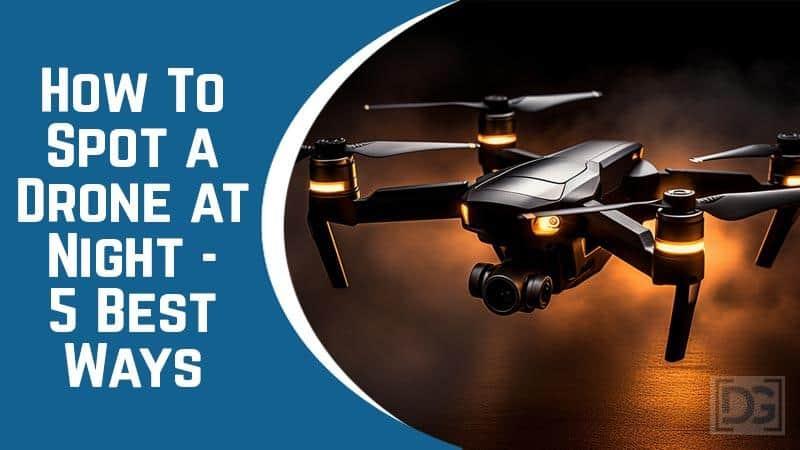
Let’s explore the shadowy world of nocturnal drones and learn how to spot them before they spot us.
Quick Answer: Drones at night can be identified by their distinct red glow, specific movement patterns, and the buzzing sound of their propellers.
They often resemble bright stars, but with a closer look, their unique characteristics become evident.
Alright, ready to embark on this nocturnal journey? Let’s unravel the secrets of the night sky, one drone at a time.
And hey, if you’ve got a drone story of your own, don’t be shy! Share it in the comments.
After all, the night is dark and full of… drones? 😉
5 Best Ways to Spot a Drone at Night
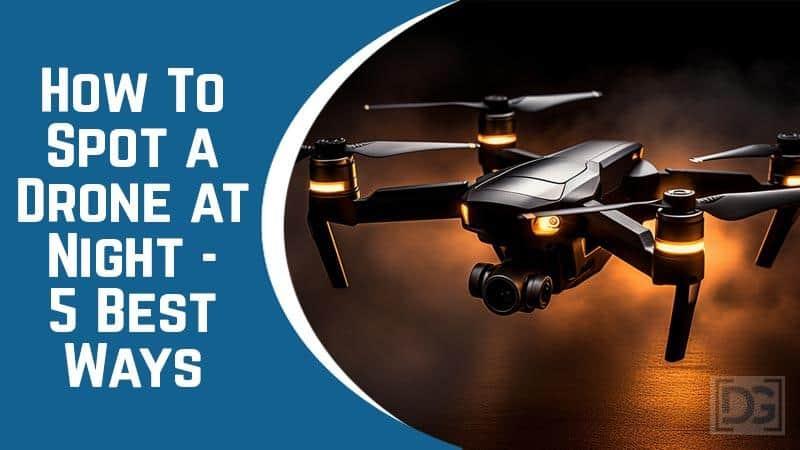
As someone who’s spent countless hours capturing the beauty of the dark through my camera lens and piloting drones, I’ve got some nifty tricks up my sleeves.
And guess what? I’m about to spill the beans!
Whether you’re a concerned citizen or a drone aficionado, here are five tried-and-true methods to spot those buzzing wonders in the night sky.
1. Tune In to the Sounds of the Night
Ever been on a quiet evening stroll and heard a faint buzzing, somewhat like a distant swarm of bees or a far-off electric razor? That’s the distinct hum of a drone!
- Listen closely: Drones, especially when they’re close, emit a consistent whirring sound due to their propellers. It’s a rhythmic buzz that stands out from the natural sounds of the night.
2. Lights, Camera, Action!
Drones often come equipped with lights that blink and dance in the night.
- Color cues: Typically, the front lights are white, while the rear lights are red. On the sides, you might spot green lights on the right and blue on the left.
- Count ’em: Most drones have at least four lights, one on each arm. However, the number can vary based on the drone model.
- Blink and you might miss it: Some drones have unique blinking patterns, especially when signaling a low battery or loss of signal.
3. Tech to the Rescue: Drone Detectors
In our tech-savvy world, there are devices specifically designed to detect drones. Handy, right?
- How they work: These gadgets pick up on drone signals, alerting you of their presence.
- Examples:
- AeroScope by DJI: A comprehensive drone detection system. Price: Starts at $10,000.
- DroneWatcher by DeTect: Combines multiple detection technologies. Price: Around $5,000 for a basic setup.
- SkySafe: Offers both detection and countermeasures. Price: Starting at $20,000 for advanced setups.
4. There’s an App for That!
Just as you thought you had enough apps, here’s another one that might just become your favorite.
- Real-time info: Get updates on drone activity in your vicinity.
- Examples:
- DroneWatcher APP: This app turns your Android smartphone or tablet into a drone detector. It detects, tracks, and records information on 95% of consumer drones.
- UAV Forecast: While primarily for drone pilots to check flying conditions, it can also be used to predict drone activity in an area based on favorable conditions.
5. Feeling the Heat with Infrared
Some advanced drones emit heat, especially if they’ve been flying for a while.
- Thermal signatures: Devices that detect heat can spot drones based on their thermal footprint.
- Night vision: Some binoculars or cameras with night vision can also pick up on this heat. For instance, the Bushnell Equinox Z night vision monocular starts at around $200, while more advanced binoculars like the ATN BinoX 4K can go up to $800 or more.
With these five methods in your arsenal, you’re all set to become a pro at drone spotting!
And hey, next time you spot one, give a little wave. Who knows, there might be a fellow drone enthusiast (like yours truly) on the other end, capturing the beauty of the night.
What Does a Drone Look Like at Night?
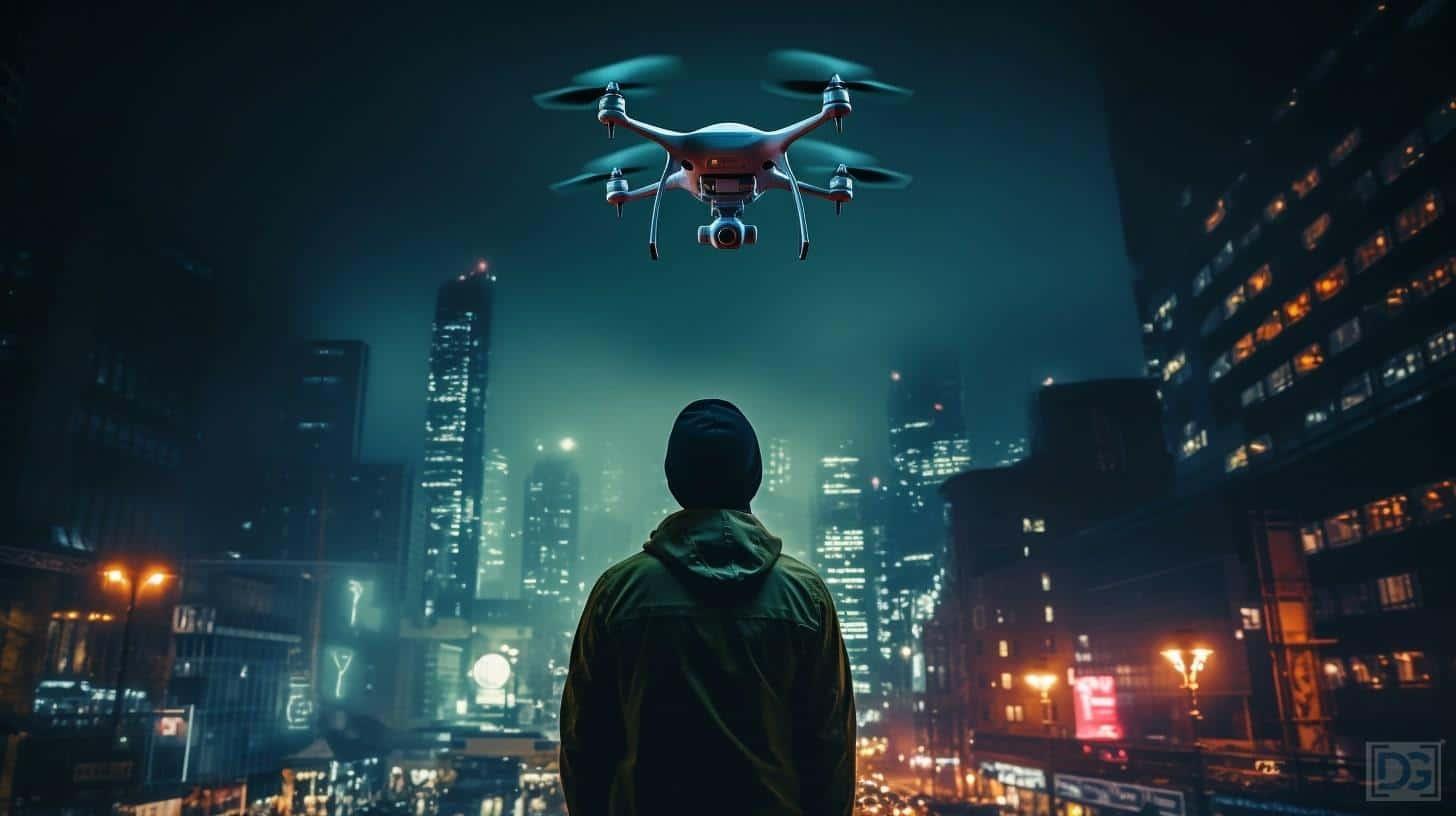
Since I am often behind the lens, capturing the ethereal beauty of the nocturnal world, I’ve had my fair share of “Is that a UFO?” moments.
Spoiler alert: It’s usually a drone. But how can you tell?
The Red Glow of Modern Tech
You know that eerie red glow you sometimes spot in the night sky? No, it’s not Mars having a close encounter with Earth. It’s the light of a drone!
Purpose of the Glow: This isn’t just for show. Drones use these lights primarily for navigation and safety. It’s like their way of saying, “Hey, I’m here! Watch out!”
The front lights are often white and the rear lights are red. On the sides, green lights are often on the right and blue on the left. Most drones have four lights or more.
Close-Up View: If you’re lucky enough to have a drone hover near you (or if you’re piloting one yourself), it can look like a cluster of bright stars.
Distinguishing Drones from Distant Airplanes
From afar, that red light might make you think of an airplane. But here’s the catch:
Size Matters: While some drones can be as big as a Toyota Camry, most consumer drones are much smaller. So if it looks like a distant plane but seems to be closer to the ground, you might just be looking at a drone.
Movement Gives It Away: Drones have a more erratic flight pattern compared to the steady trajectory of airplanes. They can hover, move sideways, and even fly backward. If it’s dancing in the sky, it’s probably a drone.
Stars or Drones?
On a clear night, with thousands of stars twinkling above, how do you spot the odd one out?
Brightness: Drones tend to shine brighter than most stars. If one ‘star’ seems to outshine the others, take a closer look.
The Telltale Movement: Stars twinkle but drones move. If that ‘star’ starts zipping across the sky, well, you’ve got your answer!
With these tips in hand, you’re all set to differentiate between the celestial and the technological.
How to Spot a Police Drone at Night
We’ve all seen those police cars with flashing lights, but what about police drones?
Yep, they’re a thing!
You might be curious about how these law-enforcing birds differ from the ones we hobbyists fly. Or perhaps you’re just keen on ensuring that Big Brother isn’t watching.
Either way, let’s dive in!
Characteristics of Police Drones vs. Regular Drones
By observing and understanding these characteristics, you can better differentiate between a police drone and a regular one when spotting them in the night sky.
Now, police drones aren’t out there wearing tiny police caps or badges (though that would be adorable, wouldn’t it?). But they do have some distinguishing features:
Usually police drones can also stay up in the air longer, but that may be hard to detect just from looking at it.
Purpose Matters
Understanding why a drone is in the vicinity can be crucial. Is it capturing breathtaking cityscapes or is it on a surveillance mission?
Surveillance: Police drones are often deployed for surveillance, especially during large public events or searches.
Traffic Monitoring: Ever been stuck in a traffic jam and wished you had a bird’s-eye view? Police drones often assist in monitoring traffic situations and accidents.
What Color Lights Do Police Drones Have at Night
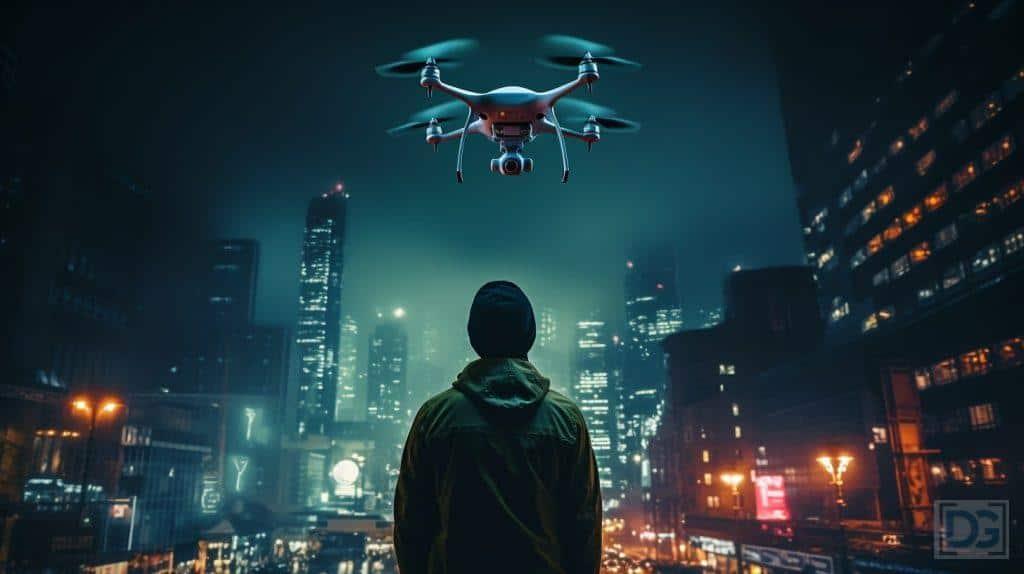
Ah, the pièce de résistance! The lights can give away a lot.
Blue & Red: Just like their ground counterparts, police drones often sport blue and red lights. It’s their signature style!
Flashing Patterns: These lights might flash in a distinct pattern, signaling their official nature. So, if you spot a drone with alternating blue and red lights, it’s probably the police keeping an eye out.
The next time you’re out at night, gazing at the sky, and you spot a drone with that official blue-red combo, give a nod of respect to our airborne officers.
And if you’re flying your own drone, maybe keep it on its best behavior. After all, the sky’s the limit, but rules are rules!
What Do Surveillance Drones Look Like at Night?
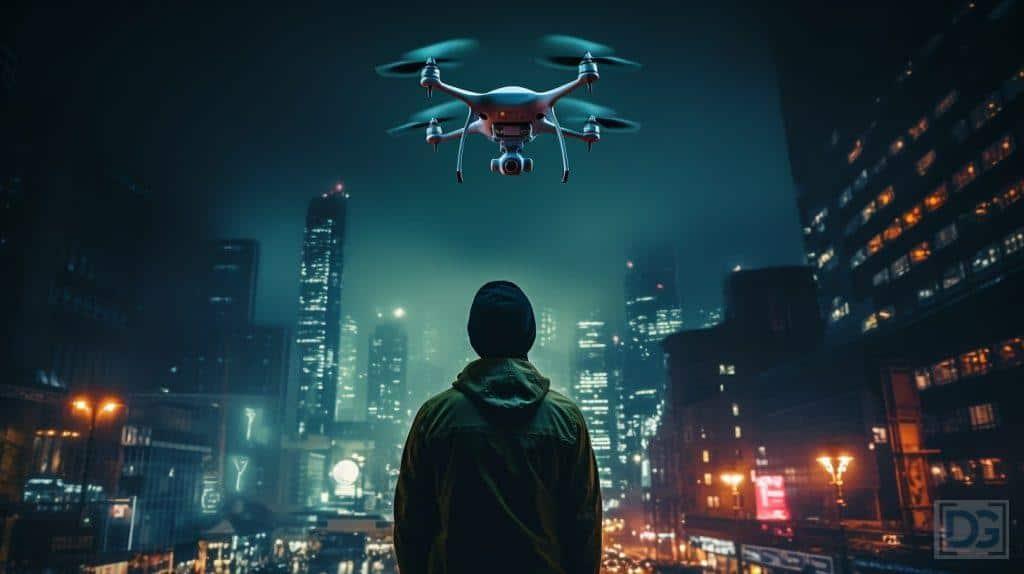
Unlike their recreational siblings, surveillance drones are designed to be discreet. They’re the ninjas of the drone world!
- Size & Design: These drones are often compact and designed to blend in with the night sky. Think of them as the chameleons of modern tech.
- Minimal Lighting: While most drones have lights for navigation, surveillance drones might have dimmer lights or even use infrared lights invisible to the naked eye.
Light Patterns & Movements
Even the stealthiest of drones have some giveaways. Here’s what to look out for:
- Erratic Movements: Surveillance drones might change directions frequently, especially if they’re tracking something (or someone).
- Hovering: If you notice a ‘star’ that’s been in the same spot for a tad too long, it might just be a drone keeping an eye on something below.
Special Equipment Onboard
These drones aren’t just flying around aimlessly. They’ve got a job to do, and they come equipped for it!
- High-Resolution Cameras: To capture clear footage, even in low light.
- Zoom Capabilities: To get a closer look without physically moving closer.
- Thermal Imaging: Some advanced surveillance drones can detect heat signatures, making them effective even if you’re hiding in the shadows.
The next time you’re out and about on a starry night, and you get that eerie feeling of being watched, just remember these tips.
And who knows, maybe it’s just a fellow drone enthusiast capturing the beauty of the night.
But it’s always better to be informed, right? Stay curious and keep looking up!
Beeing Watched? Check Out This Guide to Drone Jammers.
How to Tell if a Drone is Watching and Spying on You at Night
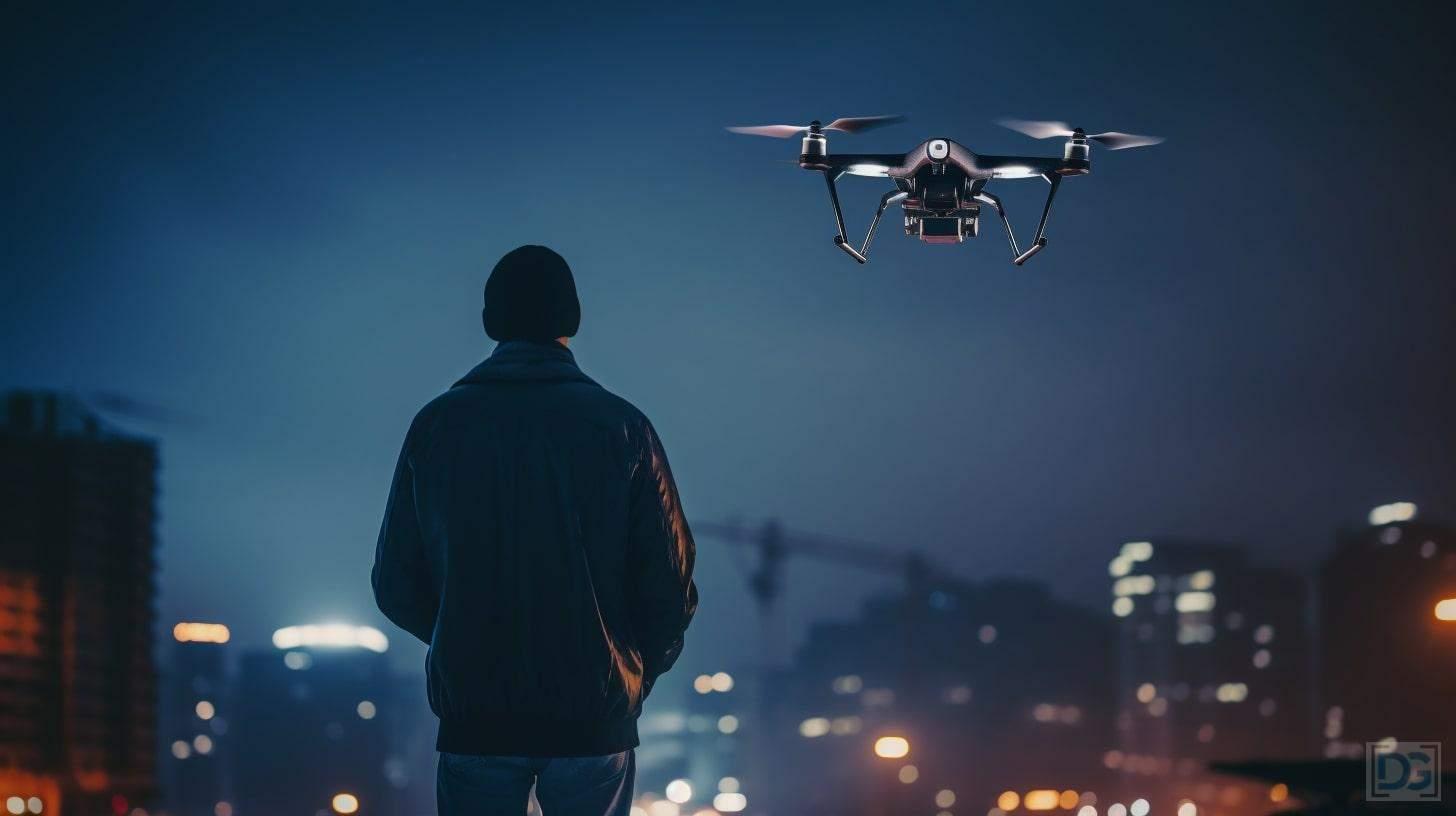
Ever had that spine-tingling feeling that you’re being watched? No, I’m not talking about that creepy neighbor from apartment 3B. I’m talking about drones!
It’s not always easy to tell if a drone is just passing by or if it’s got its camera trained on you.
The Hovering Game
Drones, especially surveillance ones, have this pesky habit of hovering when they’re trying to get a good shot. It’s like they’re trying to say, “Hold on, just getting my focus right!”
- Duration Matters: If a drone is hovering around a particular area for an extended period, it might be observing something (or someone).
- Altitude Insights: Surveillance drones might fly at a lower altitude to get clearer footage, especially in low light conditions.
Camera Direction: The Telltale Sign
Here’s a pro tip from someone who’s spent countless hours behind the drone camera: The camera’s direction can give away a lot!
- Gimbal Movements: Most advanced drones have gimbals that move the camera independently of the drone’s body. If you see the camera tilting or panning in your direction, it’s time to strike a pose (or, you know, duck for cover).
- Lens Reflection: At night, if the drone’s camera lens catches a source of light, it might reflect it. A tiny glint in the sky could be a drone’s camera lens catching the moonlight.
Specialized Equipment Onboard
Not all drones are made equal. Some come with fancy equipment that screams “I’m watching you!”
- Zoom Lenses: If the drone has a bulky camera underneath, it might be equipped with a zoom lens. And trust me, they can see a lot from a distance.
- Infrared & Thermal Cameras: Some drones can see heat signatures. So even if you’re hiding in the shadows, they can spot you by the warmth of your body.
Behavioral Clues
Drones, much like us humans, have behaviors that can give away their intentions.
- Erratic Movements: If a drone suddenly changes its path and starts following you, it’s a clear sign it’s interested in you.
- Return to Position: After a brief movement, if the drone returns to its original position above a particular area, it’s likely monitoring that spot.
What Does a Drone Sound Like at Night?
Ah, the symphony of the night! Crickets chirping, the distant hoot of an owl, and… the buzzing of a drone? Yep, that’s right. Drones have a distinct nighttime serenade of their own.
If you’ve ever been near a beehive, you might have an inkling of what a drone sounds like. But let’s dive a bit deeper, shall we?
- Pitch & Frequency: Drones emit a consistent buzzing sound, much like a swarm of bees. The pitch can vary based on the drone’s size and the speed of its propellers.
- Volume: The closer the drone, the louder the buzz. But remember, some advanced drones are designed to be quieter, making them a tad trickier to detect.
Comparing with Common Nighttime Sounds
To the untrained ear, it might be easy to confuse the drone’s hum with other nocturnal noises. Here’s a quick guide:
- Crickets: Their chirping is rhythmic and intermittent. Drones, on the other hand, have a steady hum.
- Night Birds: Birds like owls have a more melodic call, while drones maintain their consistent buzz.
- Wind: A gusty night might produce rustling leaves and creaking branches, but drones have a mechanical quality to their sound.
Factors Affecting Audibility
Not all drones are created equal, and several factors can influence how they sound:
- Distance: Naturally, the further away the drone, the fainter its sound.
- Background Noise: If you’re in a bustling city or near a roaring waterfall, the drone’s hum might be drowned out.
- Drone Size: Bigger drones with larger propellers tend to be louder.
So, the next time you’re out stargazing or enjoying a midnight stroll, tune your ears to the sounds around you. Who knows, you might just pick up on the distant hum of a drone capturing the night’s magic.
Advanced Drone Technologies for Nighttime Operations

I’ve seen firsthand how drones have evolved over the years. And let me tell you, the advancements in nighttime operations are nothing short of spectacular.
Let’s explore the world of drones after dark.
Low-light Cameras: The Night Owls of the Drone World
The Magic Behind Them: These cameras are designed to capture high-quality images even in minimal light. Think of them as the cat’s eyes of the drone world.
Applications: Beyond surveillance, these cameras are a boon for photographers aiming to capture the serene beauty of the nocturnal world.
Fun Fact: Ever tried capturing the Northern Lights with a standard camera? Good luck! But with a low-light camera on a drone, the vibrant colors come alive.
Night-vision Technology: Seeing the Unseen
How It Works: These cameras use infrared light to illuminate the surroundings, allowing the drone to “see” in complete darkness.
Infrared Cameras: A key component in night-vision tech. They detect heat rather than light, making them perfect for spotting living creatures or warm objects.
Advantages: Infrared light is invisible to the human eye, so drones using this tech can operate stealthily at night. Handy for wildlife photographers or, well, spies.
Cameras Mimicking Human Night Vision: The Future is Here
Signal Amplification: These cameras amplify available light to create a brighter image. So, even on a moonless night, they can capture detailed images.
Noise Reduction: Ever noticed grainy images when taking photos in low light? These cameras reduce that “noise,” ensuring crisp, clear images.
Real-world Application: Imagine capturing the twinkle of stars, the glow of city lights, and the shimmer of a distant river, all in one shot. With these cameras, it’s possible!
FAQ on Spoting a Drone at Night
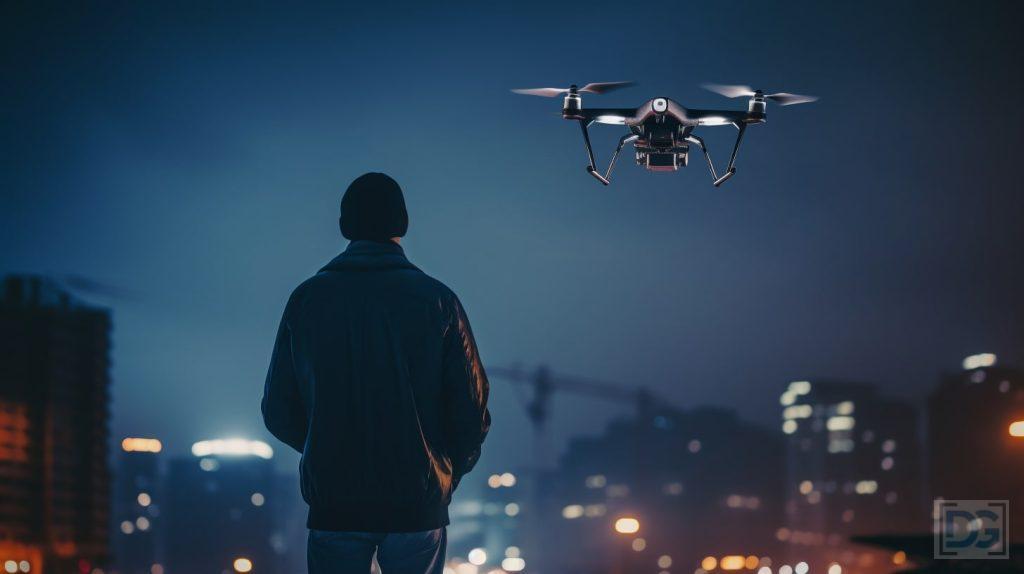
Q: How can I detect a drone in the night sky?
A: To spot drones at night, look for white light patterns or motion detection alerts. Drones flying at night often have lights that make them easier to spot against the backdrop of the night sky.
Q: What makes drones see at night? Do they have night vision?
A: Yes, many commercial drones are equipped with night vision cameras. These cameras allow the drone to see at night, especially wildlife and property at night, using thermal or infrared imaging.
Q: I’ve heard about drone detector apps. How do they help in detection?
A: Drone detector apps can alert you to the presence of a drone nearby. They use various signals to detect a drone at night, making it much easier to spot them, especially around your property at night.
Q: Are there specific detectors for spotting drones in the night sky?
A: Yes, there are specialized drone detectors designed to help you spot drones even at night. These detectors can identify the type of drone, be it a commercial drone or a spy drone, based on their signals and characteristics.
Q: How can I tell if a police drone is nearby?
A: Police drones often have distinct features, such as blue and red lights. If you see these lights in the night sky and detect the drone using a drone detector app, it’s likely a police drone flying around.
Q: What should I be aware of if I suspect a drone is spying on me at night?
A: If you believe a drone is spying on you at night, try to spot the drone’s lights or listen for its distinct buzzing sound. Spy drones might hover or circle around your property at night. Using night vision or thermal cameras at night can also help in identifying such drones.
Q: Can I hear a drone even at night?
A: Absolutely! Drones make a characteristic buzzing sound when they fly. This sound can be heard even at night, making it easier to spot a drone that is nearby.
Q: How do drones operate with wildlife at night?
A: Drones equipped with night vision cameras can observe wildlife at night without disturbing them. The drone’s ability to see at night ensures they can capture clear footage of nocturnal animals in their natural habitat.
Conclusion: Night Owls and Drones – A Guide to Locating Them
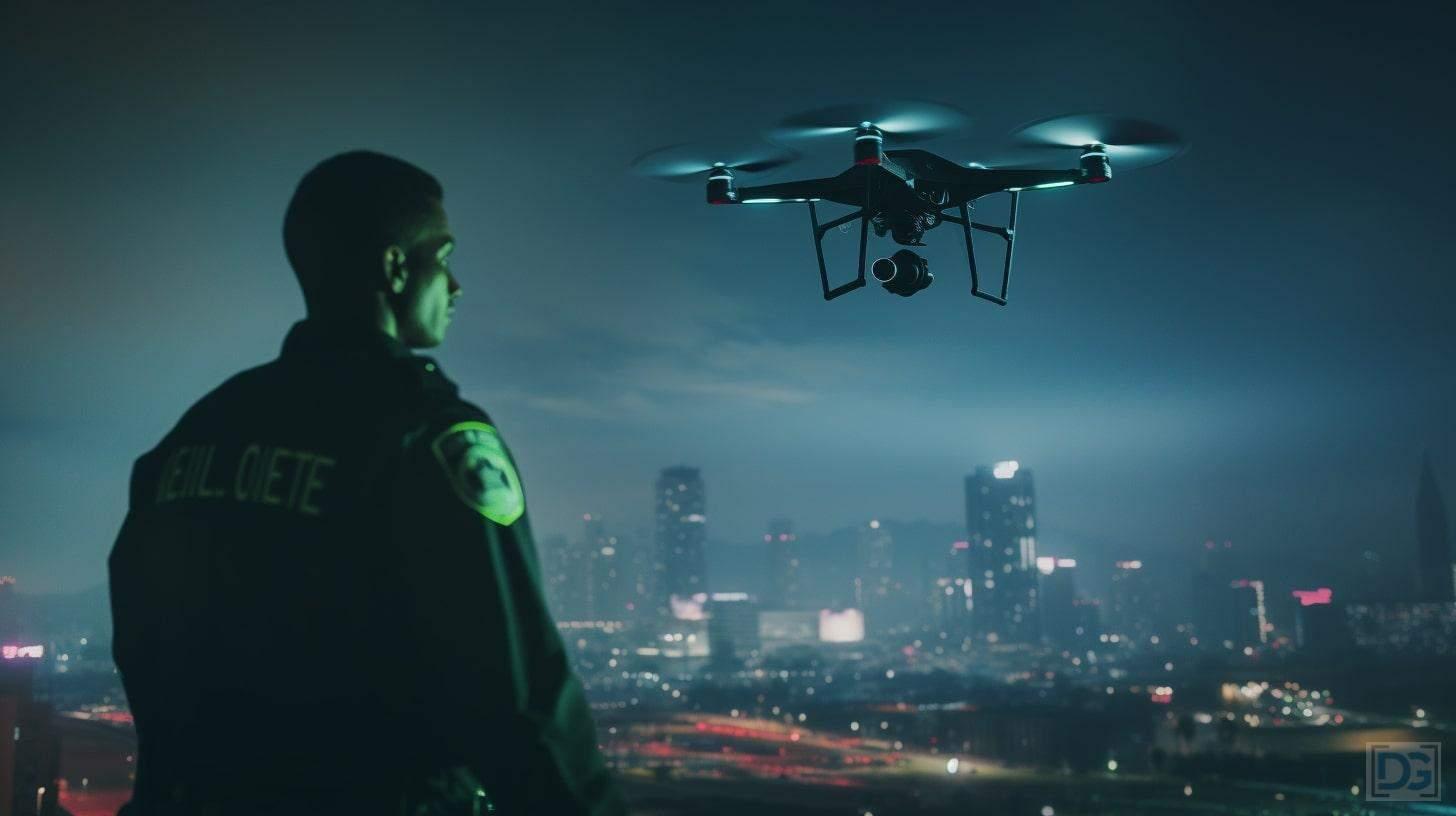
Remember when the night sky was just about spotting constellations and wishing on shooting stars? Well, times have changed, and now we’ve got drones joining the party.
Whether you’re a privacy-conscious individual or a drone enthusiast like me, it’s good to know how to spot them when the sun goes down.
Why Should You Care?
For Privacy: Let’s face it, nobody likes the idea of being watched, especially when you’re in your backyard trying to enjoy a quiet evening. Knowing how to spot a drone can give you peace of mind.
Quick Recap: Spotting 101
- Listen Up! Drones have a distinct buzzing sound. It’s like a bee, but on steroids.
- Flashy Lights: Most drones have lights that blink in patterns. Red, blue, green – it’s like a mini disco up there.
- Sky Gazing: Drones move differently than, say, a bird or a plane. Look for patterns and movements that seem out of place.
- Tech to the Rescue: There are apps and gadgets that can help you detect drones. A bit geeky, but super useful.

